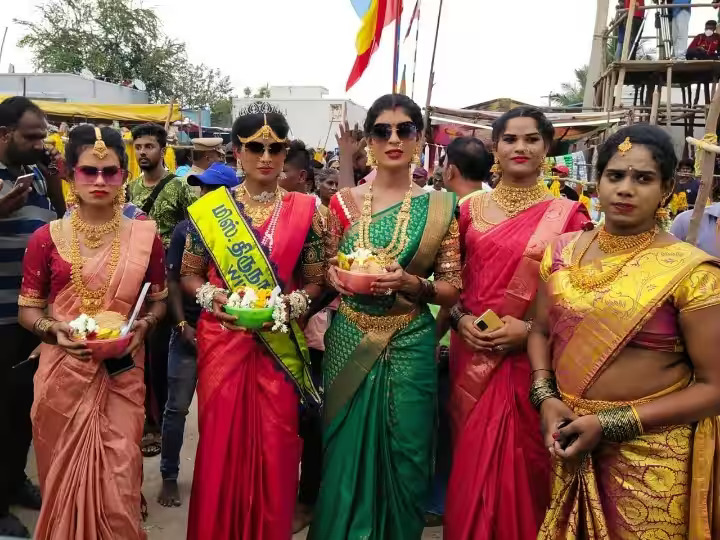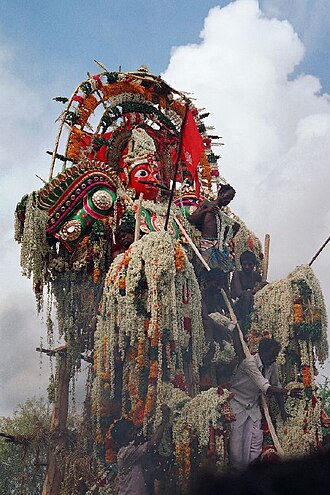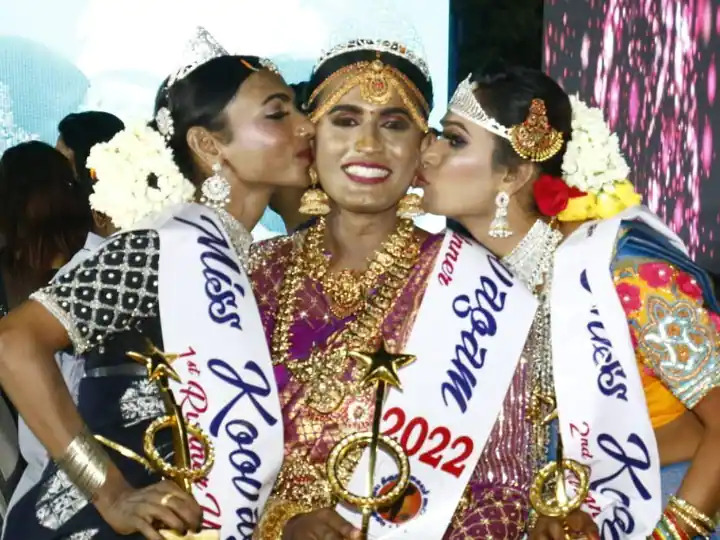
From the beginning of time, the world has been divided between binaries: male and female. Since birth, this label of male or female is determined on the basis of genitalia and these biological characteristics in modern day parlance is represented by the term ‘sex’. Unlike sex, ‘gender’ is a sociological term which generally refers to the socially constructed role, behaviors, activities and traits that a given society considers relevant for men and women. Those who don’t fit these two identities are termed as ‘third gender’ or are called transgenders. Due to their non-confirming nature, they are secluded from mainstream society.
To reduce this seclusion from the society, this community of non-conformists would come together in a festival called Koovagam Koothandavar. Koovagam is a small village located 25 kilometers away from Villupuram district in the southern state of Tamil Nadu. It is often identified as a ‘sleepy village’ which would only come to life during the Koovagam festival. It is seen as a nucleus of a massive transgender and transvestite gathering in India and people from India and all over the globe are a part of it. This annual religious festival is celebrated in the month of Chithirai (Chaitra) in the Tamil calendar and falls in April and May. It is celebrated for 18 days and various activities are conducted each day.

Koovagam or Kuthandavar Mela is celebrated to pay homage to Lord Aravan who is the major patron of Koothandavar temple.Kuttantavar is another name for Aravan.He is also a patron of Thirungai, a notable transgender community of Tamil Nadu.
The story of this festival lies behind the Hindu epic of Mahabharata. Usually, it is said that, on the last day of the Kurukshetra war between Kauravas and Pandavas, Krishna suggested to Pandavas to sacrifice one man from their side to win the battle. When all eligible persons like Lord Krishna and Arjuna refused to volunteer, then Arjuna’s son Aravan (his mother was Naga Princess Ulupi) volunteered. But before the sacrifice, he wanted to experience the bliss of a marriage relationship. Due to his situation, no woman was ready to marry him. To fulfill the dying man’s wish, Krishna took his Mohini avatar to marry him. Then on another day, he sacrificed his life leading to Pandavas’ victory in the battle.
Hijaras often uses this myth as a way to be recognized in a mythological narration. According to some scholars like K Delliswararo and Hangsing, an attempt by Hijaras is made to showcase their presence in Ancient time by identifying themselves with Arjuna’s enigmatic gender status,along with asserting their legitimacy in the history.
The story of marriage, the sacrifice of Kuttantvar, widowhood and mourning of Mohini is depicted during the festival by the Transgenders. Transgender would identify themself as ‘Alis’ or ‘Aravanis’. In the first six days, Aravan’s head (Cami) is marched through the village streets along with music, dance and fireworks. A pooja with coconut offerings and aarti given for Aravan by every house is also performed.
Koothandavar is shown painted in red, which is a colour that invocates the feeling of strong anger, love, joy, and heat along with a colour associated with sexuality, activity and passion. A high post, ‘Kambamnirutthudal’ is built on a chariot for the procession by the evening of the fourteenth day. After this, the alis and Aravan marry through the traditional thali-tying ceremony known as mangalsutras

Then the march moves North, to face the battlefield of Kurukshetra enacting Aravan’s entry into the battlefield and his death by Alambusha.After this, the garlands adorning the Cami are detached signifying the removal of flesh and Aravan’s death and this all happens in the symbolic Kurukshetra.Then on the 13th day, his soul is metaphorically transported to a pot and his head is repainted. A special folk dance,’ Kummi is performed for Aravan before his beheading.Apart from this,they would celebrate by dancing with the Karakkami (Aravan’s flower crown) believed of having Aravan’s power. Several cultural events would take place during the entire period for entertaining both the participant and the spectator. Like the beauty pageant ‘Miss Koovagam’, skits, and dance performances. They would also conduct ‘Annathanam’ or distribute food to NGOs supporting disabled people. Binary finery and the husband’s grief affect them deeply.
On the 16th day, a march with the statue of Aravan on a chariot takes place. The priests would break alis’s bangles, tears the mangalsutra and also washes the vermillion (sindoor) from their heads. They would mourn their husband’s death in the Alukalam (the weeping ground) and wear white saree with unkempt hair. Finally, the festival comes to an end.Every year the festival would witness large footfalls.
In the current world of discrimination, various verdicts have been passed to make them a part of society which has partially done its job. The Supreme Court passed a verdict in 2014 in which transgenders started to identify as the ‘third gender’ after male and female. Section 377 of the Indian Penal Code, disallows an ‘unnatural sexual act’ which is called sex apart from heterosexual intercourse.
In addition to this, their representation in Kollywood movies like Kanchana and Super Deluxe influences the viewers who would connect and sympathize with them.
From ancient times society has never treated Transgenders equally. They face discrimination and various harassment and their homosexuality and bisexuality are considered as ‘western pollution’ in the society. The Koovagam festival, nonetheless allows them to be free of any boundations and judgements, as all similar people would come together to celebrate this festival. Apart from this, it is also a chance for them to find love and family for them. Thus the festival was both a place for the religious ceremony along with the empowerment and space of equal representation for all transgender. Moreover, Transgender from any religion was permitted to attend the festival increasing the reach for the same.
Though now the situation is getting a little better than in the past as transgenders are getting jobs in some sectors and also they’re revered before any occasion. We hope that in the coming years they’ll get the representation for which they’ve been fighting for years.

Sanskriti Pundir
Sanskriti Pundir is currently pursuing a Bachelor's degree in History Honours from Indraprastha College for Women. She is determined and is also a budding writer who actively seeks opportunities to improve her writing skills.

